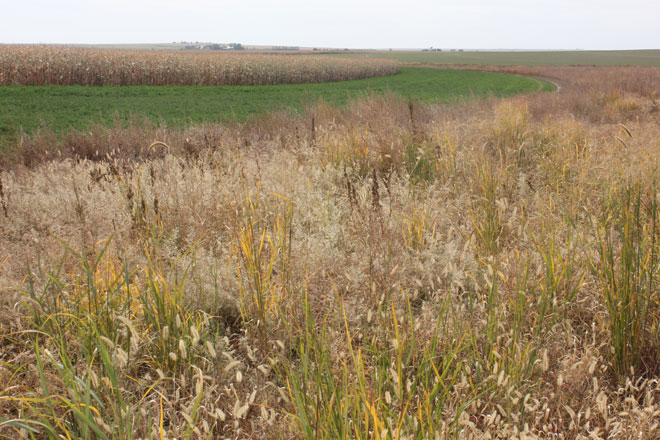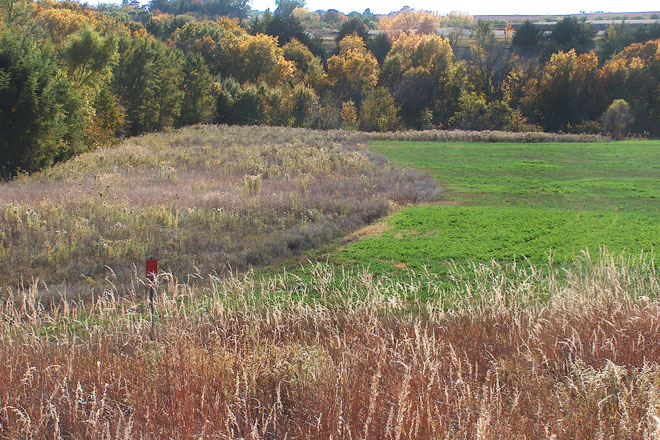By Ariel Wiegard
The Conservation Reserve Program (more commonly known as “CRP”) was created when President Ronald Reagan signed a
Farm Bill into law on December 23, 1985. Since then, Congress has reauthorized and updated the program six times, and the U.S. Department of Agriculture has enthusiastically implemented this vital initiative across tens of millions of acres nationwide, to the lasting benefit of pheasants, quail, and all those who love agriculture and the outdoors. Nearly 40 years after its creation, CRP remains one of the greatest conservation gifts we’ve ever received.
It’s a nice coincidence that December 23 is also right in the middle of a season rich with appreciative gestures and counting our blessings. Let us pause to thank our devoted chapters, volunteers, and staff, whose boots on the ground make CRP an effective habitat tool, and let’s celebrate some of the many benefits of our favorite voluntary, incentive-based private lands conservation program:
- Wildlife Habitat: Thanks to the conservation and restoration of millions of acres of land to diverse grasses and other locally beneficial types of plants, myriad animal species across the U.S., including threatened and endangered ones, have been able to call CRP “home.” Bees, monarch butterflies, and other insects and pollinators (a.k.a. wild bird food) have all benefited, as have populations of pheasants, quail, ducks, prairie chickens, sharp-tailed grouse, turkeys, deer, and many other game and non-game species. CRP acreage is currently at its highest since 2014, with more than five million acres enrolled in just the last three years. Upland hunters can cheer that we’re seeing better bird numbers alongside this rise in CRP enrollment.

- Soil Health: CRP has helped enhance soil health by reducing erosion and promoting better soil structure on less productive farmland. It has significantly reduced loss of precious topsoil (which nourishes our crops, livestock forage, and wild plant communities), conserving millions of tons annually—more than 9 billion tons of soil have been saved from eroding, enough to fill over 600 million dump trucks.
- Water Quality: By restoring more than three million acres of wetlands and establishing riparian forest and grass buffers on more than 175,000 stream miles (enough to go around the world seven times!), CRP improves water quality by limiting the amount of soil, fertilizer, and other crucial agricultural inputs that run off from farm fields. This has improved the health of rivers, streams, lakes, and even the Gulf of Mexico by reducing nitrogen and phosphorous runoff by 95 and 85 percent respectively, relative to annually tilled cropland.
- Carbon Sequestration: CRP has played a crucial role in sequestering carbon. By conserving soil and establishing vegetation for 10 years or more, landowners enrolled in CRP have sequestered 49 million tons of greenhouse gases each year on average, equal to taking 9 million cars off the road.
- Boosting the Bottom Line: Beyond environmental advantages, CRP economically benefits farmers, ranchers, and other private landowners through steady, annual rental payments for land enrolled in the program for 10-15 years at a time. CRP also enables organizations like PF & QF to improve producers’ bottom lines by helping to “turn red acres green”—using precision data to increase profits through voluntary use of targeted conservation practices. CRP has even served as part of the farm safety net, reducing risk on cropped acres and providing emergency forage in areas stricken by wildfire and drought.
- Access and Opportunity: CRP also supports rural economies by fostering tourism related to hunting, wildlife, and other outdoor activities. CRP acres are often enrolled in access programs that incentivize willing landowners to open private lands to public hunting, and can provide key wildlife corridors near public lands that see heavy hunting and fishing pressure.
CRP is one of America’s largest and most effective conservation programs. From its original purpose in 1985 of controlling soil erosion and stabilizing commodity prices, this Farm Bill program has evolved over the years to be a true working lands program. Not only do CRP acres provide forage and grazing for livestock, but these lands are also working to create wildlife habitat, healthy soil, and abundant clean water; these lands are always producing something we as humans truly need!

So, as we gather to celebrate the holiday season with family and friends, I’m confident many folks reading this will be sneaking away for a winter pheasant or quail hunt as well. I’m also confident many of us will be chasing birds on acres of habitat made possible by one of the greatest conservation gifts in American history—the Conservation Reserve Program.
At PF & QF, we’re here to make sure future generations of hunters are able to enjoy these same holiday adventures.
The most recent five-year Farm Bill was signed into law in 2018, and Congress is currently working with stakeholders of all stripes—including PF & QF—on a new Farm Bill. One of PF & QF’s top policy priorities is to ensure inclusion in the next Farm Bill of a fully funded and sustainable CRP that continues to work for farmers, ranchers, and the environment. That will be one more big thing to celebrate!
Advocating for Conservation
It takes good habitat to produce abundant wildlife and opportunities to hunt—but it also takes robust public funding and sound conservation policy to shape that habitat. Pheasants Forever and Quail Forever’s dedicated Government Affairs team works in Washington D.C. and state capitols across America to create and secure funding for programs that benefit the uplands, from the rugged backcountry to the neighboring farm’s “back 40.” To learn more about our policy priorities and ways you can help advocate for conservation, visit
this page.
Ariel Wiegard is Vice President of Governmental Affairs with Pheasants Forever and Quail Forever.